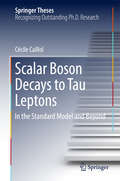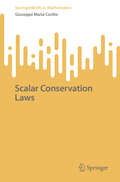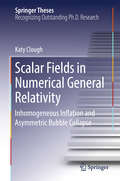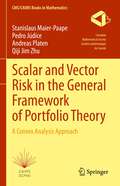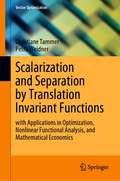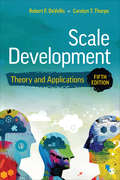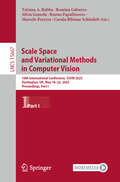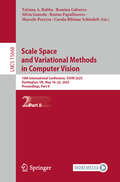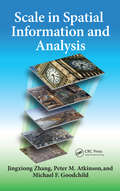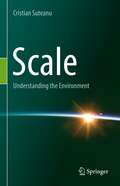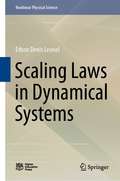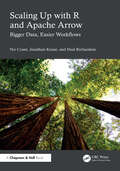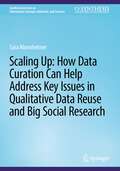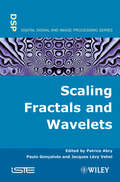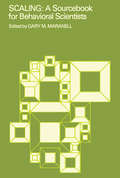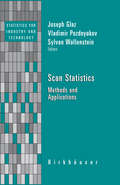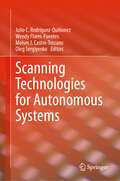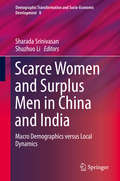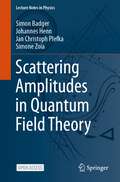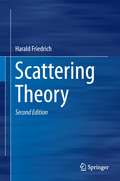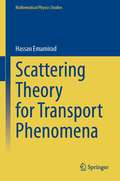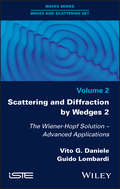- Table View
- List View
Scalar Boson Decays to Tau Leptons: in the Standard Model and Beyond (Springer Theses)
by Cécile CaillolThis thesis presents a study of the scalar sector in the standard model (SM), as well as various searches for an extended scalar sector in theories beyond the SM (BSM). The first part of the thesis details the search for an SM Higgs boson decaying to taus, and produced by gluon fusion, vector boson fusion, or associated production with a vector boson, leading to evidence for decays of the Higgs boson to taus. In turn, the second part highlights several searches for an extended scalar sector, with scalar boson decays to taus. In all of the analyses presented, at least one scalar boson decays to a pair of taus. The results draw on data collected by the Compact Muon Solenoid (CMS) detector during proton–proton collisions with a center-of-mass energy of 7 or 8 TeV.
Scalar Conservation Laws (SpringerBriefs in Mathematics)
by Giuseppe Maria CocliteThis book are notes prepared for the PhD courses that the author has been teaching during the last 10 years. The material available in the already existing literature (papers and essays) has been collected in this unique text, presenting the results with all the details for the reader’s convenience, fixing a unified notation, and providing a consistent framework for the subject. These notes cover many of the arguments that usually can be found in high level essays, where the proofs are simply sketched, and in papers, which are not easily available and not always self-contained.This book is intended for1. PhD students in Mathematics, Physics and Mechanical Engineering in order to learn the basic features of nonlinear scalar equations,2. researchers interested in nonlinear hyperbolic PDEs in order to learn the details behind some known and deep results on nonlinear scalar equations,3. teachers of courses on nonlinear PDEs.The readers are expected to know the basic measure theory and Sobolev spaces.
Scalar Fields in Numerical General Relativity: Inhomogeneous Inflation and Asymmetric Bubble Collapse (Springer Theses)
by Katy CloughThis book explores the use of numerical relativity (NR) methods to solve cosmological problems, and describes one of the first uses of NR to study inflationary physics. NR consists in the solution of Einstein’s Equation of general relativity, which governs the evolution of matter and energy on cosmological scales, and in systems where there are strong gravitational effects, such as around black holes. To date, NR has mainly been used for simulating binary black hole and neutron star mergers like those detected recently by LIGO. Its use as a tool in fundamental problems of gravity and cosmology is novel, but rapidly gaining interest. In this thesis, the author investigates the initial condition problem in early universe cosmology – whether an inflationary expansion period could have “got going” from initially inhomogeneous conditions – and identifies criteria for predicting the robustness of particular models. State-of-the-art numerical relativity tools are developed in order to address this question, which are now publicly available.
Scalar and Vector Risk in the General Framework of Portfolio Theory: A Convex Analysis Approach (CMS/CAIMS Books in Mathematics #9)
by Qiji Jim Zhu Stanislaus Maier-Paape Pedro Júdice Andreas PlatenThis book is the culmination of the authors’ industry-academic collaboration in the past several years. The investigation is largely motivated by bank balance sheet management problems. The main difference between a bank balance sheet management problem and a typical portfolio optimization problem is that the former involves multiple risks. The related theoretical investigation leads to a significant extension of the scope of portfolio theories. The book combines practitioners’ perspectives and mathematical rigor. For example, to guide the bank managers to trade off different Pareto efficient points, the topological structure of the Pareto efficient set is carefully analyzed. Moreover, on top of computing solutions, the authors focus the investigation on the qualitative properties of those solutions and their financial meanings. These relations, such as the role of duality, are most useful in helping bank managers to communicate their decisions to the different stakeholders. Finally, bank balance sheet management problems of varying levels of complexity are discussed to illustrate how to apply the central mathematical results. Although the primary motivation and application examples in this book are focused in the area of bank balance sheet management problems, the range of applications of the general portfolio theory is much wider. As a matter of fact, most financial problems involve multiple types of risks. Thus, the book is a good reference for financial practitioners in general and students who are interested in financial applications. This book can also serve as a nice example of a case study for applied mathematicians who are interested in engaging in industry-academic collaboration.
Scalarization and Separation by Translation Invariant Functions: with Applications in Optimization, Nonlinear Functional Analysis, and Mathematical Economics (Vector Optimization)
by Christiane Tammer Petra WeidnerLike norms, translation invariant functions are a natural and powerful tool for the separation of sets and scalarization. This book provides an extensive foundation for their application. It presents in a unified way new results as well as results which are scattered throughout the literature. The functions are defined on linear spaces and can be applied to nonconvex problems. Fundamental theorems for the function class are proved, with implications for arbitrary extended real-valued functions. The scope of applications is illustrated by chapters related to vector optimization, set-valued optimization, and optimization under uncertainty, by fundamental statements in nonlinear functional analysis and by examples from mathematical finance as well as from consumer and production theory. The book is written for students and researchers in mathematics and mathematical economics. Engineers and researchers from other disciplines can benefit from the applications, for example from scalarization methods for multiobjective optimization and optimal control problems.
Scale Development: Theory and Applications (Applied Social Research Methods)
by Robert F. DeVellis Carolyn T. ThorpeScale Development: Theory and Applications, by Robert F. DeVellis and new co-author Carolyn T. Thorpe, demystifies measurement by emphasizing a logical rather than strictly mathematical understanding of concepts. The Fifth Edition includes a new chapter that lays out the key concepts that distinguish indices from scales, contrasts various types of indices, suggests approaches for developing them, reviews validity and reliability issues, and discusses in broad terms some analytic approaches. All chapters have been updated, and the book strikes a balance between including relevant topics and highlighting recent developments in measurement while retaining an accessible, user-friendly approach to the material covered.
Scale Development: Theory and Applications (Applied Social Research Methods)
by Robert F. DeVellis Carolyn T. ThorpeScale Development: Theory and Applications, by Robert F. DeVellis and new co-author Carolyn T. Thorpe, demystifies measurement by emphasizing a logical rather than strictly mathematical understanding of concepts. The Fifth Edition includes a new chapter that lays out the key concepts that distinguish indices from scales, contrasts various types of indices, suggests approaches for developing them, reviews validity and reliability issues, and discusses in broad terms some analytic approaches. All chapters have been updated, and the book strikes a balance between including relevant topics and highlighting recent developments in measurement while retaining an accessible, user-friendly approach to the material covered.
Scale Space and Variational Methods in Computer Vision: 10th International Conference, SSVM 2025, Dartington, UK, May 18–22, 2025, Proceedings, Part I (Lecture Notes in Computer Science #15667)
by Carola-Bibiane Schönlieb Tatiana A. Bubba Romina Gaburro Silvia Gazzola Kostas Papafitsoros Marcelo PereyraThe two-volume set LNCS 15667 and 15668 constitutes the proceedings of the 10th International Conference on Scale Space and Variational Methods in Computer Vision, SSVM 2025, which took place in Dartington, UK, in May 2025. The total of 63 full papers accepted in the proceedings were carefully reviewed and selected from 81 submissions. They were organized in topical sections as follows: Part I: Inverse Problems in Imaging; machine and deep learning in imaging; Part II: Optimization for imaging: theory and methods; scale space, PDES, flow, motion and registration.
Scale Space and Variational Methods in Computer Vision: 10th International Conference, SSVM 2025, Dartington, UK, May 18–22, 2025, Proceedings, Part II (Lecture Notes in Computer Science #15668)
by Carola-Bibiane Schönlieb Tatiana A. Bubba Romina Gaburro Silvia Gazzola Kostas Papafitsoros Marcelo PereyraThe two-volume set LNCS 15667 and 15668 constitutes the proceedings of the 10th International Conference on Scale Space and Variational Methods in Computer Vision, SSVM 2025, which took place in Dartington, UK, in May 2025. The total of 63 full papers accepted in the proceedings were carefully reviewed and selected from 81 submissions. They were organized in topical sections as follows: Part I: Inverse Problems in Imaging; machine and deep learning in imaging; Part II: Optimization for imaging: theory and methods; scale space, PDES, flow, motion and registration.
Scale in Spatial Information and Analysis
by Michael F. Goodchild Jingxiong Zhang Peter AtkinsonNow ubiquitous in modern life, spatial data present great opportunities to transform many of the processes on which we base our everyday lives. However, not only do these data depend on the scale of measurement, but also handling these data (e.g., to make suitable maps) requires that we account for the scale of measurement explicitly. Scale in Spat
Scale: Understanding the Environment
by Cristian SuteanuThis book provides up-to-date, in-depth and accessible information on the concept of scale, and focuses on its applications in geography, Earth science, environmental science, and other fields in which the environment plays a significant role. Although the book presents methods and applications as a response to practical challenges, it is primarily concept-centered: it identifies a set of distinct, yet related notions of “scale”, analyzing and elucidating their evolving meanings in a systematic way. Concepts are defined with a focus on their practical operational applicability, and the introduction of methods is supported by concrete examples. The book links theoretical insights to illustrating applications, involving a broad range of themes, from maps, fractals, and chaos theory to fine art and literature. It approaches the subject in a spatial, temporal, and spatio-temporal context, including a wide diversity of spatial features from Earth and other planets, as well as time series and space-time patterns. This monograph is expected to be useful especially because in practice the various scale-focused concepts are not neatly separated and immiscible. It is therefore helpful for scholars in physical and human geography, Earth and environmental sciences, and other fields, to benefit from a clear conceptual framework that distinguishes and illuminates the various scale-related concepts and their interconnections. Selected chapters can also support a deeper understanding of the concept of scale for graduate and undergraduate students in geography, the natural sciences, and the humanities. Information on recommended additional literature and comments about specific sources offer a guide to further reading on the topics addressed in the book.
Scaling
by Grigory Isaakovich BarenblattMany phenomena in nature, engineering or society when seen at an intermediate distance, in space or time, exhibit the remarkable property of self-similarity: they reproduce themselves as scales change, subject to so-called scaling laws. It's crucial to know the details of these laws, so that mathematical models can be properly formulated and analysed, and the phenomena in question can be more deeply understood. In this 2003 book, the author describes and teaches the art of discovering scaling laws, starting from dimensional analysis and physical similarity, which are here given a modern treatment. He demonstrates the concepts of intermediate asymptotics and the renormalisation group as natural attributes of self-similarity and shows how and when these notions and tools can be used to tackle the task at hand, and when they cannot. Based on courses taught to undergraduate and graduate students, the book can also be used for self-study by biologists, chemists, astronomers, engineers and geoscientists.
Scaling Laws in Dynamical Systems (Nonlinear Physical Science)
by Edson Denis LeonelThis book discusses many of the common scaling properties observed in some nonlinear dynamical systems mostly described by mappings. The unpredictability of the time evolution of two nearby initial conditions in the phase space together with the exponential divergence from each other as time goes by lead to the concept of chaos. Some of the observables in nonlinear systems exhibit characteristics of scaling invariance being then described via scaling laws. From the variation of control parameters, physical observables in the phase space may be characterized by using power laws that many times yield into universal behavior. The application of such a formalism has been well accepted in the scientific community of nonlinear dynamics. Therefore I had in mind when writing this book was to bring together few of the research results in nonlinear systems using scaling formalism that could treated either in under-graduation as well as in the post graduation in the several exact programs but no earlier requirements were needed from the students unless the basic physics and mathematics. At the same time, the book must be original enough to contribute to the existing literature but with no excessive superposition of the topics already dealt with in other text books. The majority of the Chapters present a list of exercises. Some of them are analytic and others are numeric with few presenting some degree of computational complexity.
Scaling Up Machine Learning
by John Langford Ron Bekkerman Mikhail BilenkoThis book presents an integrated collection of representative approaches for scaling up machine learning and data mining methods on parallel and distributed computing platforms. Demand for parallelizing learning algorithms is highly task-specific: in some settings it is driven by the enormous dataset sizes, in others by model complexity or by real-time performance requirements. Making task-appropriate algorithm and platform choices for large-scale machine learning requires understanding the benefits, trade-offs, and constraints of the available options. Solutions presented in the book cover a range of parallelization platforms from FPGAs and GPUs to multi-core systems and commodity clusters, concurrent programming frameworks including CUDA, MPI, MapReduce, and DryadLINQ, and learning settings (supervised, unsupervised, semi-supervised, and online learning). Extensive coverage of parallelization of boosted trees, SVMs, spectral clustering, belief propagation and other popular learning algorithms and deep dives into several applications make the book equally useful for researchers, students, and practitioners.
Scaling Up with R and Apache Arrow: Bigger Data, Easier Workflows
by Nic Crane Jonathan Keane Neal RichardsonAnalyze large datasets directly from R. Scaling Up With R and Arrow provides a guide to working efficiently with larger-than-memory datasets using the arrow R package. As data grows in size and complexity, traditional data analysis methods in R often hit technical limitations. In this book, you'll learn how to overcome these hurdles without needing to set up complex infrastructure.You'll learn about the Apache Arrow project's origins, goals, and its significance in bridging the gap between data science and big data ecosystems. You'll also learn how to leverage the arrow R package to work directly with files in various formats, such as CSV and Parquet, using familiar dplyr syntax. This book explores practical topics like data manipulation, file formats, working with larger datasets, and optimizing workflows for data in cloud storage. Advanced chapters examine user-defined functions, integration with other tools like DuckDB, and extending Arrow's capabilities to work with geospatial data.Written by developers of the Arrow R package, this guide is essential for anyone looking to scale their data processing capabilities in R.
Scaling Up: How Data Curation Can Help Address Key Issues in Qualitative Data Reuse and Big Social Research (Synthesis Lectures on Information Concepts, Retrieval, and Services)
by Sara MannheimerThis book explores the connections between qualitative data reuse, big social research, and data curation. A review of existing literature identifies the key issues of context, data quality and trustworthiness, data comparability, informed consent, privacy and confidentiality, and intellectual property and data ownership. Through interviews of qualitative researchers, big social researchers, and data curators, the author further examines each key issue and produces new insights about how domain differences affect each community of practice’s viewpoints, different strategies that researchers and curators use to ensure responsible practice, and different perspectives on data curation. The book suggests that encouraging connections between qualitative researchers, big social researchers, and data curators can support responsible scaling up of social research, thus enhancing discoveries in social and behavioral science.
Scaling, Fractals and Wavelets (Wiley-iste Ser.)
by Patrice Abry Paulo Gonçalves Jacques Lévy VéhelScaling is a mathematical transformation that enlarges or diminishes objects. The technique is used in a variety of areas, including finance and image processing. This book is organized around the notions of scaling phenomena and scale invariance. The various stochastic models commonly used to describe scaling ? self-similarity, long-range dependence and multi-fractals ? are introduced. These models are compared and related to one another. Next, fractional integration, a mathematical tool closely related to the notion of scale invariance, is discussed, and stochastic processes with prescribed scaling properties (self-similar processes, locally self-similar processes, fractionally filtered processes, iterated function systems) are defined. A number of applications where the scaling paradigm proved fruitful are detailed: image processing, financial and stock market fluctuations, geophysics, scale relativity, and fractal time-space.
Scaling: A Sourcebook for Behavioral Scientists (Neural Information Processing Ser.)
by Peter Jordan Caroline LloydDespite the obvious importance of measurement in any scientific endeavor, few students of the social sciences receive adequate training in the principles and problems of assigning numerical values to the subjects, objects, events, groups and operations they study, and still less in the process of translating theoretical ideas and concepts into variables. This kind of casualness with respect to measurement is often in marked contrast to their methodically designed research, which has grown out of subtle and sophisticated theoretical consideration.Scaling is intended to remedy this deficiency by providing a broad and detailed description of the major processes for developing measurement scales. The chapters, which include both classics in the field and the best of modern work, require no great mathematical sophistication, and go well beyond the conventional study of attitudes to the more general uses of scaling. They enable the student and researcher to examine the development of measures of scalability and the problems and weaknesses they present, to become familiar with the development of tests of significance for reproducibility and scalability and the need for them, and to examine the lively history of the subject and experience the excitement that can be secured from sharing with a creative author the first report of his insight.Part One presents a series of general articles that deal in philosophic terms with the problem of measurement, with what is meant by measurement and scaling as well as the notions underlying the process of measuring. Part Two deals with the scaling methods developed by L. L. Thurstone, including paired comparison scaling, equal-appearing interval scaling, and successive interval scaling. The third part focuses upon scalogram analysis, presenting the background, rationale and procedures for Guttman scaling. The fourth part is concerned with summated rating, or Likert scaling. Part Five is a consideration of unfold
Scan Statistics
by Vladimir Pozdnyakov Joseph Glaz Sylvan WallensteinScan statistics is currently one of the most active and important areas of research in applied probability and statistics, having applications to a wide variety of fields: archaeology, astronomy, bioinformatics, biosurveillance, molecular biology, genetics, computer science, electrical engineering, geography, material sciences, physics, reconnaissance, reliability and quality control, telecommunication, and epidemiology. Filling a gap in the literature, this self-contained volume brings together a collection of selected chapters illustrating the depth and diversity of theory, methods and applications in the area of scan statistics.
Scanning Technologies for Autonomous Systems
by Oleg Sergiyenko Wendy Flores-Fuentes Julio C. Rodríguez-Quiñonez Moises J. Castro-ToscanoThis book provides the theory, methodology, and uses of scanning technologies for the application of autonomous systems. The authors provide readers with an understanding of different technologies and methods to perform scanning technologies and their optimal application depending on the kind of autonomous system. Also, the book presents a compilation of original high-quality contributions and research results from worldwide authors on emerging new autonomous systems based on different scanning technologies. This book is a valuable reference for engineering professionals and the scientific community.
Scarce Women and Surplus Men in China and India
by Sharada Srinivasan Shuzhuo LiThis volume documents how families, communities and some groups (single men, young 'scarce' women, parents) adapt and adjust to recent demographic shifts in China and India. It discusses how demographic change interacts with other processes of change, including changes with respect to economic development and globalization, gender, class, caste, families, migration and work. The chapters offer micro-level analyses contextualized in larger processes of change and push further existing understandings of the consequences of the demographic imbalance between men and women in China and/or India, particularly from a gender perspective. As such this book will be of interest to scholars and students in population studies, sociology, international development, gender studies, and Asian studies.
Scattering Amplitudes in Quantum Field Theory (Lecture Notes in Physics #1021)
by Simone Zoia Simon Badger Johannes Henn Jan Christoph PlefkaThis open access book bridges a gap between introductory Quantum Field Theory (QFT) courses and state-of-the-art research in scattering amplitudes. It covers the path from basic definitions of QFT to amplitudes, which are relevant for processes in the Standard Model of particle physics. The book begins with a concise yet self-contained introduction to QFT, including perturbative quantum gravity. It then presents modern methods for calculating scattering amplitudes, focusing on tree-level amplitudes, loop-level integrands and loop integration techniques. These methods help to reveal intriguing relations between gauge and gravity amplitudes and are of increasing importance for obtaining high-precision predictions for collider experiments, such as those at the Large Hadron Collider, as well as for foundational mathematical physics studies in QFT, including recent applications to gravitational wave physics.These course-tested lecture notes include numerous exercises with solutions. Requiring only minimal knowledge of QFT, they are well-suited for MSc and PhD students as a preparation for research projects in theoretical particle physics. They can be used as a one-semester graduate level course, or as a self-study guide for researchers interested in fundamental aspects of quantum field theory.
Scattering Theory
by Harald FriedrichThis book presents a concise and modern coverage of scattering theory. It is motivated by the fact that experimental advances have shifted and broadened the scope of applications where concepts from scattering theory are used, e.g. to the field of ultracold atoms and molecules, which has been experiencing enormous growth in recent years, largely triggered by the successful realization of Bose-Einstein condensates of dilute atomic gases in 1995. In the present treatment, special attention is given to the role played by the long-range behaviour of the projectile-target interaction, and a theory is developed, which is well suited to describe near-threshold bound and continuum states in realistic binary systems such as diatomic molecules or molecular ions. The level of abstraction is kept as low as at all possible, and deeper questions related to mathematical foundations of scattering theory are passed by. The book should be understandable for anyone with a basic knowledge of nonrelativistic quantum mechanics. It is intended for advanced students and researchers, and it is hoped that it will be useful for theorists and experimentalists alike.
Scattering Theory for Transport Phenomena (Mathematical Physics Studies)
by Hassan EmamiradThe scattering theory for transport phenomena was initiated by P. Lax and R. Phillips in 1967. Since then, great progress has been made in the field and the work has been ongoing for more than half a century. This book shows part of that progress. The book is divided into 7 chapters, the first of which deals with preliminaries of the theory of semigroups and C*-algebra, different types of semigroups, Schatten–von Neuman classes of operators, and facts about ultraweak operator topology, with examples using wavelet theory.Chapter 2 goes into abstract scattering theory in a general Banach space. The wave and scattering operators and their basic properties are defined. Some abstract methods such as smooth perturbation and the limiting absorption principle are also presented. Chapter 3 is devoted to the transport or linearized Boltzmann equation, and in Chapter 4 the Lax and Phillips formalism is introduced in scattering theory for the transport equation. In their seminal book, Lax and Phillips introduced the incoming and outgoing subspaces, which verify their representation theorem for a dissipative hyperbolic system initially and also matches for the transport problem. By means of these subspaces, the Lax and Phillips semigroup is defined and it is proved that this semigroup is eventually compact, hence hyperbolic. Balanced equations give rise to two transport equations, one of which can satisfy an advection equation and one of which will be nonautonomous. For generating, the Howland semigroup and Howland’s formalism must be used, as shown in Chapter 5. Chapter 6 is the highlight of the book, in which it is explained how the scattering operator for the transport problem by using the albedo operator can lead to recovery of the functionality of computerized tomography in medical science. The final chapter introduces the Wigner function, which connects the Schrödinger equation to statistical physics and the Husimi distribution function. Here, the relationship between the Wigner function and the quantum dynamical semigroup (QDS) can be seen.
Scattering and Diffraction by Wedges 2: The Wiener-Hopf Solution - Advanced Applications
by Vito G. Daniele Guido LombardiThe book has a dual purpose. The first is to expose a general methodology to solve problems of electromagnetism in geometries constituted of angular regions. The second is to bring the solutions of some canonical problems of fundamental importance in modern electromagnetic engineering with the use of the Wiener-Hopf technique. In particular, the general mathematical methodology is very ingenious and original. It is based on sophisticated and attractive procedures exploiting simple and advanced properties of analytical functions. Once the reader has acquired the methodology, she/he can easily obtain the solution of the canonical problems reported in the book. The book can be appealing also to readers who are not directly interested in the detailed mathematical methodology and/ or in electromagnetics. In fact the same methodology can be extended to acoustics and elasticity problems. Moreover, the proposed practical problems with their solutions constitute a list of reference solutions and can be of interests in engineering production in the field of radio propagations, electromagnetic compatibility and radar technologies.
